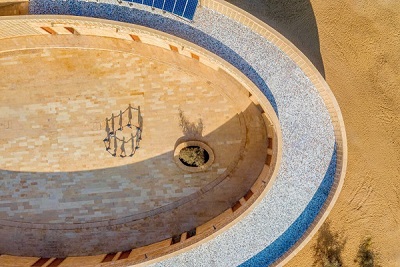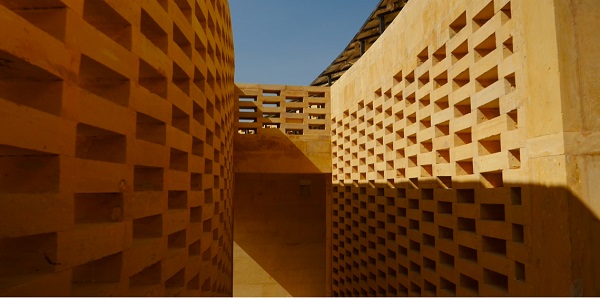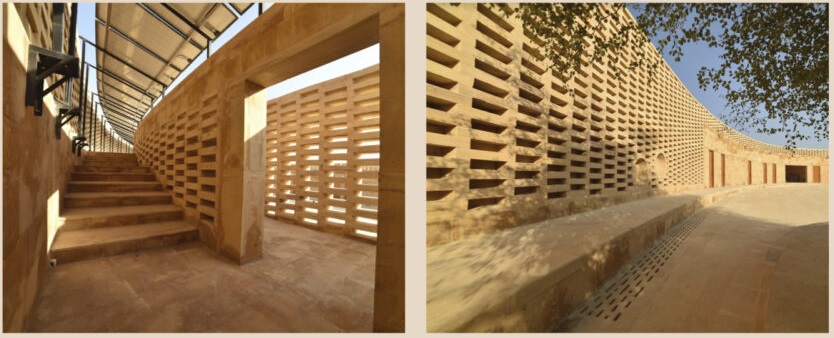The Rajkumari Ratnavati Girls School – A Detailed Look
Located in a state where the female literacy rate is the lowest in India, this school was founded by CITTA, a US non-profit organization that provides economic and education support to women in remote and marginalized communities
If you haven’t heard of The Rajkumari Ratnavati Girls School in Rajasthan, then here’s an article that will tell you all about this school that is not only an “architectural marvel”, as it’s been called, but is also spearheading education for underprivileged girls in rural Rajasthan.
It’s part of a larger project that aims to empower and provide economic independence to women (more on that later)
Located in a state where the female literacy rate is the lowest in India, this school was founded by CITTA, a US non-profit organization that provides economic and education support to women in remote and marginalized communities. It’s the first of a three-part project that will finally have a women’s cooperative center and an exhibition space (more on this below)
Today we tell you all about the school, who bult it, its goals etc. Also, if you have questions like – what is Rajkumari Ratnavati school fees, or its location, we get into that too!
Facts about Rajkumari Ratnavati Girls School

Where is Rajkumari Ratnavati Girls School located: In the Thar Desert in Rajasthan, India.
Who is the school for: The school is for girls below the poverty line who live in he Thar Desert region of Jaisalmer District, Rajasthan.
What are the facilities offered: Apart from classrooms, the school has a library and a computer center.
How do the girls come to school? There is a bus that brings the children from nearby villages.
Till what grade is the school? The school started with 140 girls from Class 1 to 4. Each year, as the students move up, a grade will be added, till they reach class 10. The school has a capacity for 400 students.
Meals given in the school: A mid-day meal is provided to the students to take care of their nutritional needs and to help the families’ financial burden.
Uniforms: The uniforms have been designed by Sabyasachi Mukherjee. Indigo in colour they incorporate the ajrakh print – a form of woodblock printing from the Sindh region.

Architecture: Designed by a US-based architect named Diana Kellogg, Rajkumari Ratnavati Girls School was named “Building of the Year” by Architectural Digest India in 2020. It is a unique, stunning, oval-shaped building that has been designed to keep cool in the blistering desert heat.
Who is the owner of Rajkumari Ratnavati Girls School?

Image Credit: CITTA
This school is a trust, but it was started by a non-profit organization named CITTA – a New York based NGO that aims to “help build and support development in some of the most economically challenged, geographically remote or marginalized communities in the world.”
It was conceptualised by CITTA founder Michael Daube, who spent about ten years thinking and working on the idea, and finding the right people to build the school. He finally took on an architect Diana Kellogg, who was based in the US. She then spent time visiting Rajasthan and designing the perfect building before the project began.
The land for this school was donated by the royal family of Jaisalmer and Manvendra Singh Shekhawat.
After many years, the school was finally constructed and opened in 2022.
Part of a larger project

The school is a part of a project named GYAAN Center for women in Jaisalmer, Rajasthan.
The first part of the GYAAN center is the school. Apart from the school the project also includes a women’s cooperative, and a market and exhibition space.
The Cooperative will be an institution that will provide women with skill training, and financial and digital literacy to give them economic independence. This training will help the women create local handicrafts that can be sold.
Central or Exhibition Hall is being planned as a marketplace where the creations made by the local women and artisans can be sold. This multi-purpose hall is visualised as an exhibition space that will also have a library.
CITTA India will help the women to connect with national and international markets for their products.
The idea is to “provide economic development, education, and skills training for girls and women residing in the Jaisalmer District and a unique outlet to enhance gender parity in the region.”
What’s so special about this school?

The main idea of the school (and the GYAAN project as a whole) is to educate and enable girls and young women to advance their education as well as raise awareness of the issues women face in India.
Michael, CITTA founder, says he chose Jaisalmer primarily because of its low literacy rate and a high dropout rate of school girls in Rajasthan. He believed that empowering and educating girls and women was the solution.
Michael wanted build a school where parents would feel a sense of pride in sending their daughters.
That said – the architecture of the building is what is also what’s remarkable about this school – we get into that a little later.
Who designed Rajkumari Ratnavati Girls School?
It was designed by a New York-based architect named Diana Kellogg.
So stunning and innovate is the building that it won many awards, being named the “Building of the Year” by Architectural Digest India in 2020.
Oval in shape, it is made with local sandstone, with its curved walls being inspired by local forts. It is built to reflect the surrounding landscape of the sand dunes of Jaisalmer. It’s a perfect combination of innovation that blends tradition and also sustainability.
Diana Kellogg says that she while the oval shape was inspired by the planes of the sand-dunes in Jaisalmer, it is also one that she believed represented femininity. Also, she said that it reflects how “children play in circles, or the women work in a community”.
When all the three buildings of the GYAAN Center are completed, they will be a structure of three ovals together, which, says Kellogg, resonates with her as “the formulation of infinity”
Keeping it cool

Jaisalmer is in the desert and the temperatures there can get to 49 degrees centigrade. Kellogg wanted to design something that makes it as cool as possible. She used a few ways to do that.
First was the oval shape, that helps keep it cool. She designed the canopy and the jalis to filter out the sand and to help in keeping the heat out. Moreover, the airflow pattern inside the building helps to cool it naturally.
There are solar panels installed on top of the building. These do two things – they work as a canopy and provide shade. They also power the building. While building the school, Kellogg used local material, which was sandstone.
There is water harvesting in the building. There is a large courtyard in the middle of the building that can harvest and store 3.5 lakh litres of water underground.
Lime Coating. The inner walls have been plastered with lime, which serves as an insulation for the building. Moreover, the local sandstone protects the building from extreme heat during the day.
The rooms are also large and ventilated to help in cooling. There are also
high ceilings and windows that work well in releasing the trapped heat in classrooms.
Using traditional techniques Kellogg created a jali wall, a kind of a grid made of sandstone that created, what’s called the Venturi effect – one where the wind accelerated in the courtyard.
There are no air conditioners in the school and the temperature inside the building is cooler than outside.
Is this a school you would like to visit? Know more here

Better Your Child’s G.K. In 3 Minutes – Get This Free Newsletter
Get fun facts, simple and easy news, quizzes, and lots of other interesting things to read in your mailbox – for free! It’s what we call GK-on-the-go!
I Kid You Not now has a large readership across India and also parts of the world. If you want to write for us, you can submit your story here. You can also apply to become a news anchor. Apply here



Comments